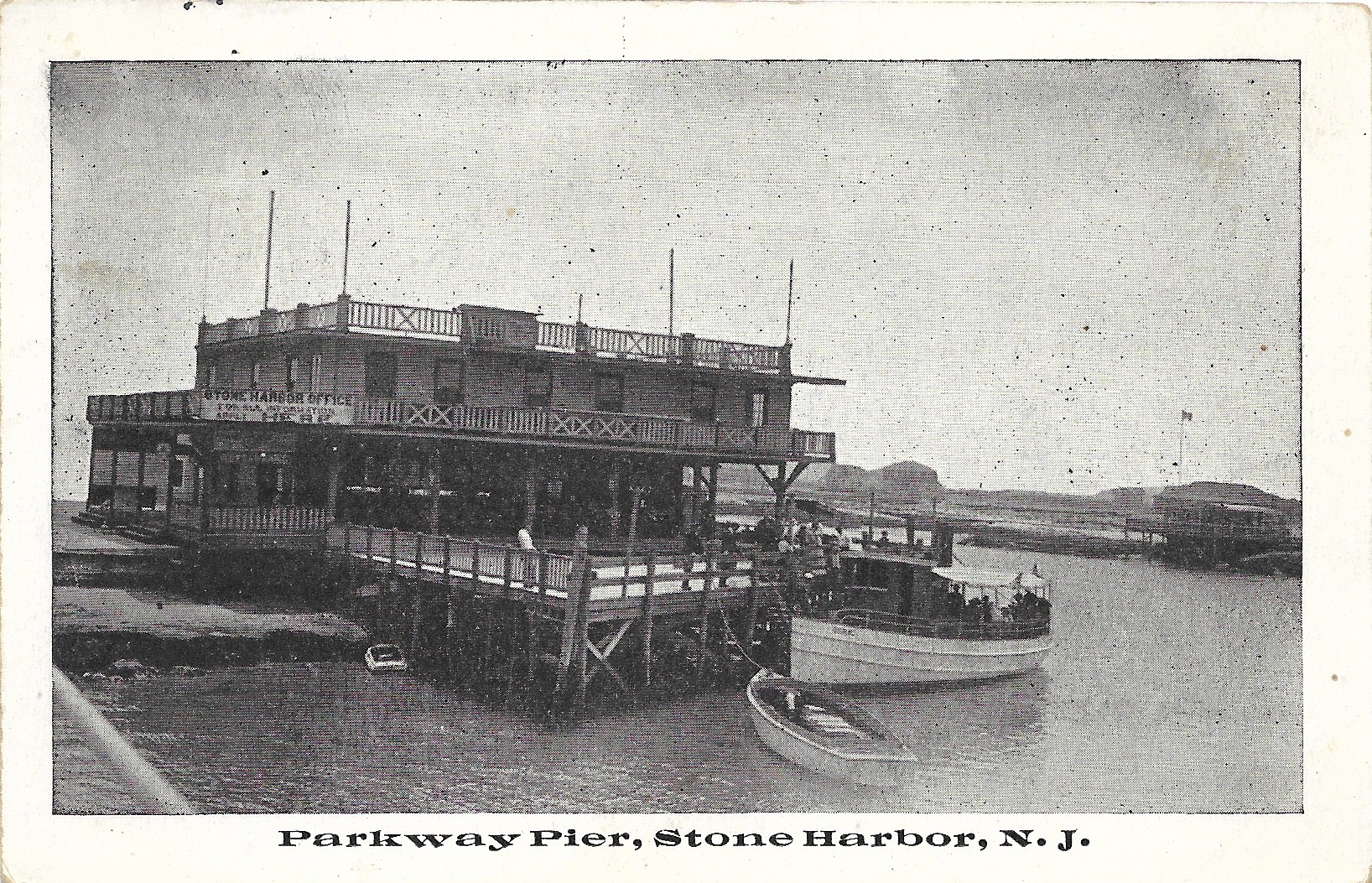
THE BACKSTORY: Thanks to the Risley brothers, Stone Harbor was originally linked to the mainland connecting Cape May Court House by way of a causeway and a bridge built in the year 1911. David, Howard and Reese Risley had also created an incorporated entity headquartered in Philadelphia in 1907 that was known as the South Jersey Realty Company. Through the issuance and selling of bonds to interested investors in exchange for free lots of land and with a creative marketing strategy including clever advertising that even utilized post cards of all things, they fostered and promoted the development of many important projects aimed at the construction of the following: large sprawling mansions and cottages, hotels, several man-made dredged basins, piers, pavilions, shops, restaurants, and a railroad depot. In addition, the Risley organization implemented and provided a host of essential infrastructural public works projects including providing an artesian water works for safe drinking water, electricity, a sanitary sewerage system, graded and wide graveled streets, concrete curbs and even sidewalks.
As you follow the Risley brothers and their remarkable progress over the next decade or so, you will understand the high level of success and many accomplishments that were taking place in Stone Harbor’s early history and the direct role the Risley’s played during that time. The post card presented above introduces us to the “PARKWAY PIER” or the main subject of this article. In fact, if one looks at the advertising sign displayed on the second story railing near the front of the building, it appears to read as follows: “STONE HARBOR OFFICE / FOR ALL INQUIRY / APPLY HERE.”
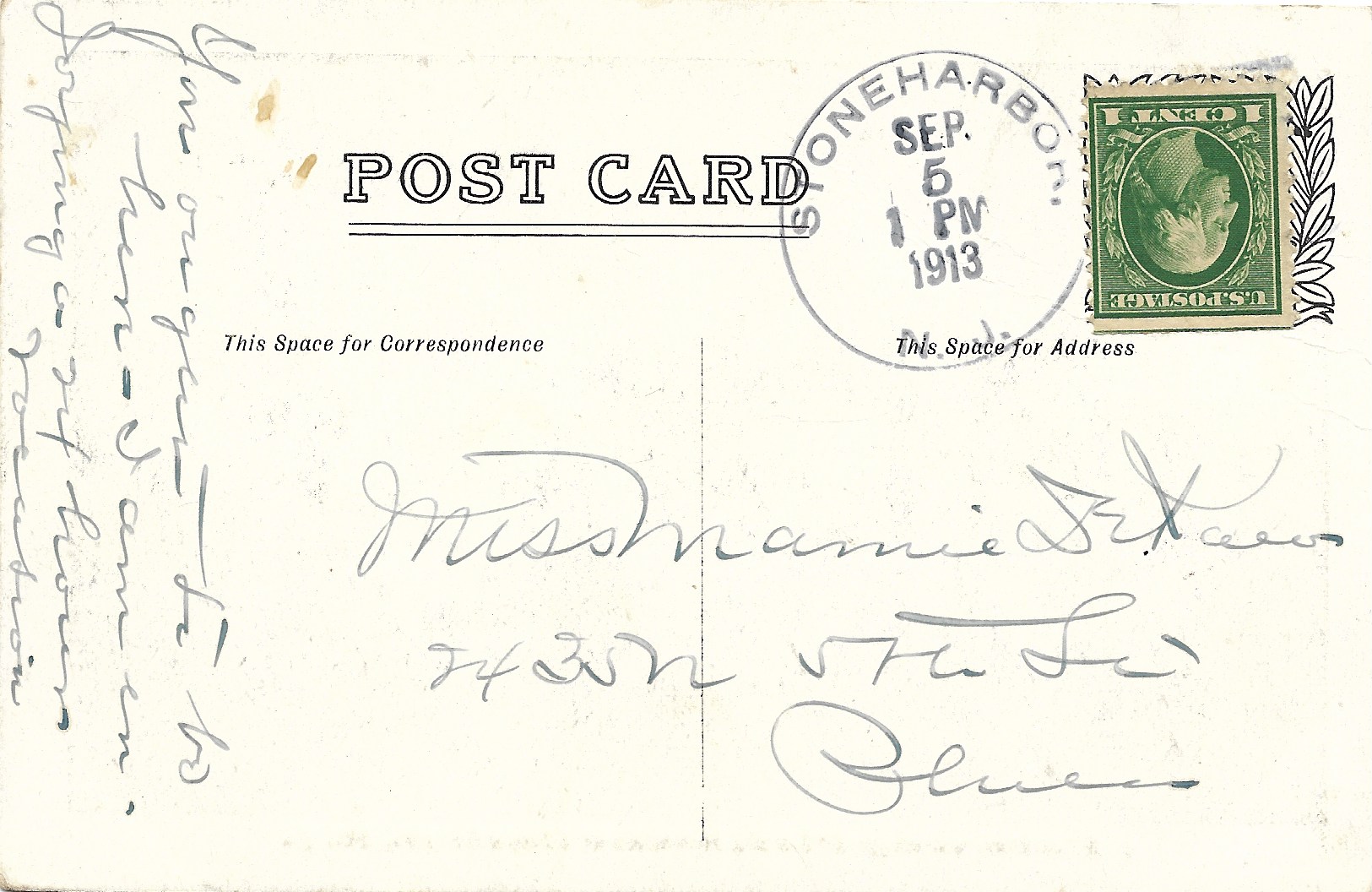
At this time I am taking the liberty of showing you both the picture side of the post card as well as the postmarked side which bears a nicely struck Stone Harbor, N. J. hand-applied postal cancellation in black ink and bearing the date SEP 5, 1 PM 1913. While I usually only show the picture side of post cards with most of my articles, every once in awhile I like to display the so-called “working side” (containing a brief written message, a postage stamp and the mailing address) of the post card. In this specific case I believe the image is indeed “classic” in appearance, adds to its authenticity and warrants your attention. In other words, what I am really saying is that in my view the message/address side of this particular post card in essence “grounds” or directly links this very post card to the story that is being told.
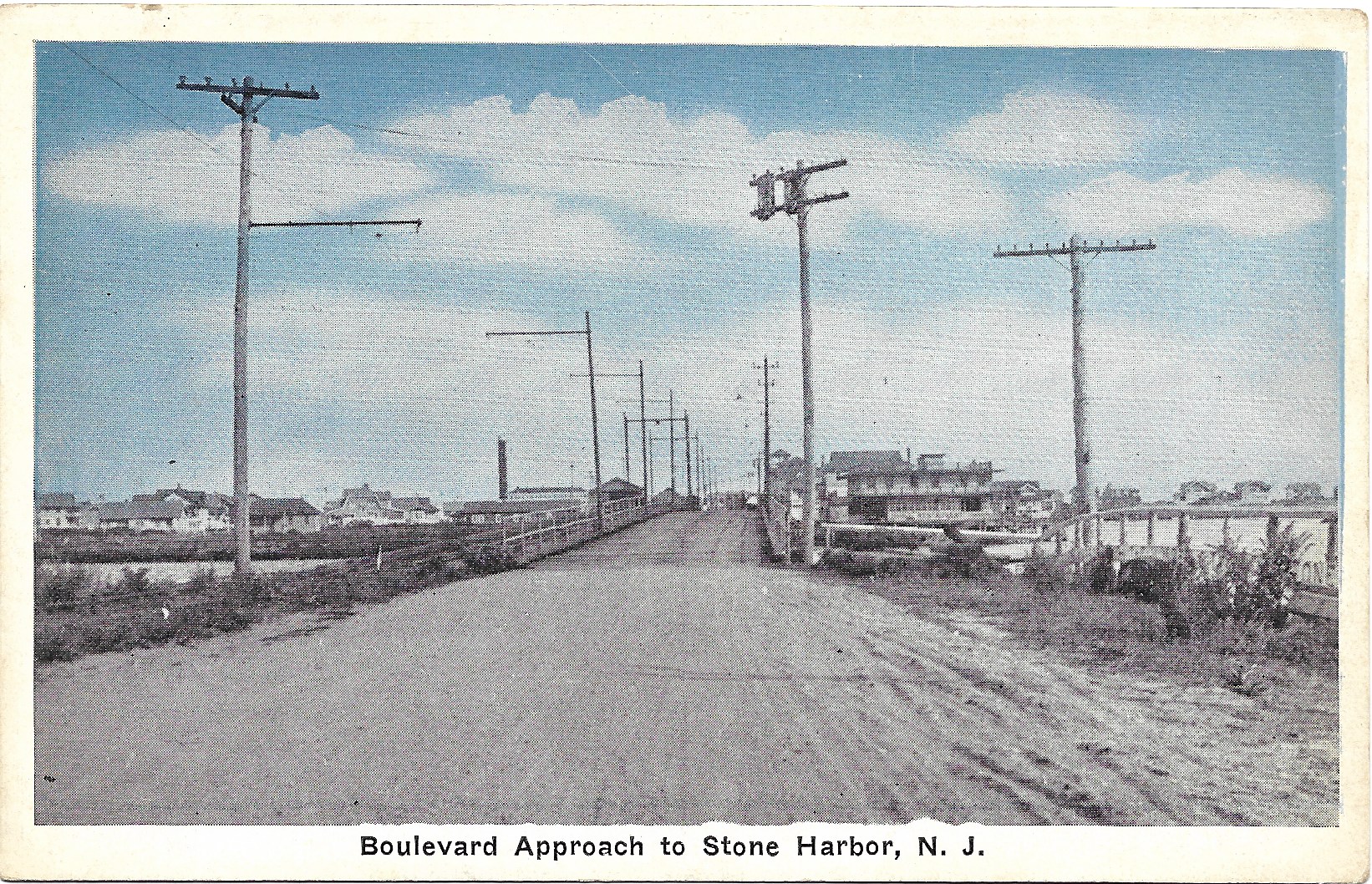
INTRODUCTION: I personally believe that one important project that the Risley’s embarked on has been somewhat overlooked. The project took place in 1912 and was an initiative that seemingly after 110 years to date has not garnered a whole lot of attention and has also been somewhat difficult to glean much factual information about. However, in addition to locating a very useful newspaper article, once again we are blessed with the fact that several vintage Stone Harbor post cards were produced and made available to show us just what that viable project was really all about with emphasis on the role it served in the community.
This second post card image looking eastward reveals the “BOULEVARD APPROACH” just outside of Stone Harbor with the Reading Railroad Bridge just ahead and the featured Risley project Parkway Pier and Pavilion House just over the bridge and being the first structure shown on the right. If you squint and look very closely, you will see the very top portion of the Shelter Haven Hotel in the background on the right and the prominent water tower looming further in the distance to the left of this image. The old interurban rail service derived power from the overhead electric power lines that are evident running into town from the mainland and shown here elevated on overhead poles extending along the left side of the road. The pier and pavilion as we understand apparently did not last all that long, but in any event, here is the story based on what we do know at this time.
We believe the story actually begins in either late 1911 or in early 1912 when South Jersey Realty Company President Howard S. Risley had a meeting one day on the Stone Harbor beach with a certain building contractor by the name of William West of West Chester, Pa. Risley’s plans called for the immediate construction of a new building that would be called the “Parkway Pier and Pavilion House” which was to be located at the mouth of the Shelter Haven Basin and 96th Street at the end of the Ocean Parkway from the mainland.
It was the intent of Howard Risley to build a much needed and the very first complete ferry house at this southern part of the state. At a cost of $10,000 this ferry house would serve as a great landing point for all commercial shuttle boats traveling between Anglesea and Stone Harbor. In addition, there would be ample dockage available for many visiting craft from all other points along the coast. Risley was clearly thinking about the future of Stone Harbor.
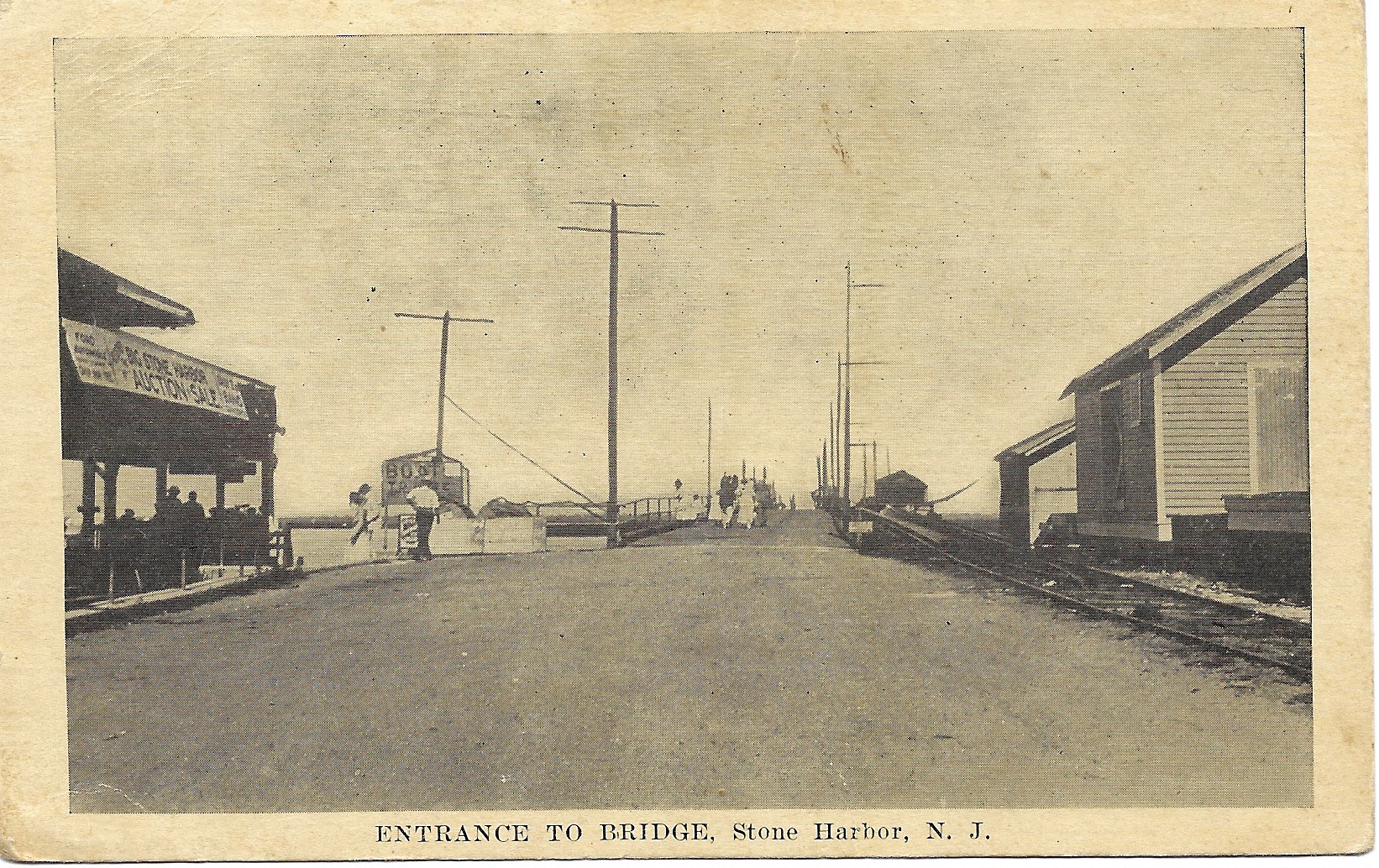
This building would be laid out in the typical or customary style of that of a seashore pavilion house with the top floor or the second story devoted to several apartments, each containing four rooms, bath and offering up-to-date amenities including furniture. The first floor however was designed to provide office space and refreshment parlors. It is no coincidence that this in fact is where the office of the South Jersey Realty Company in Stone Harbor would be conveniently located. In addition, there would be turnstiles and a ticket office for ferry passengers going to and fro using the ferry boat services.
As a means of impetus for the immediate and timely construction of this pavilion, Howard Risley indicated that in the last year (most likely 1911) there were 82,000 people who utilized ferry boat services and it was anticipated that there would be a need to transport some 150,000 people during the approaching summer season. Therefore, adding capacity was yet another way of making money for the Risleys not to mention another way to further stimulate the growth of the resort.
The post card image associated with this specific section shows the “ENTRANCE TO BRIDGE” on a quiet summer day, only this time the view depicted is from the town itself and 96th Street looking westward toward the distant mainland. Aside from the new Parkway Pavilion seen on the far left in this image, one can also notice the bridge in the center and a set of still functional railroad tracks located on the right coming off the bridge into town. One more point of interest centers on the signage prominently displayed on the Pavilion indicating from what can be determined, “BIG STONE HARBOR / AUCTION SALE”. Unfortunately, due to the lack of detail or resolution, the rest of the sign is unreadable and one can only conjecture what exactly was being advertised and made available for sale at this pavilion. In most likelihood the first floor of the pavilion was used for a range of ancillary purposes.
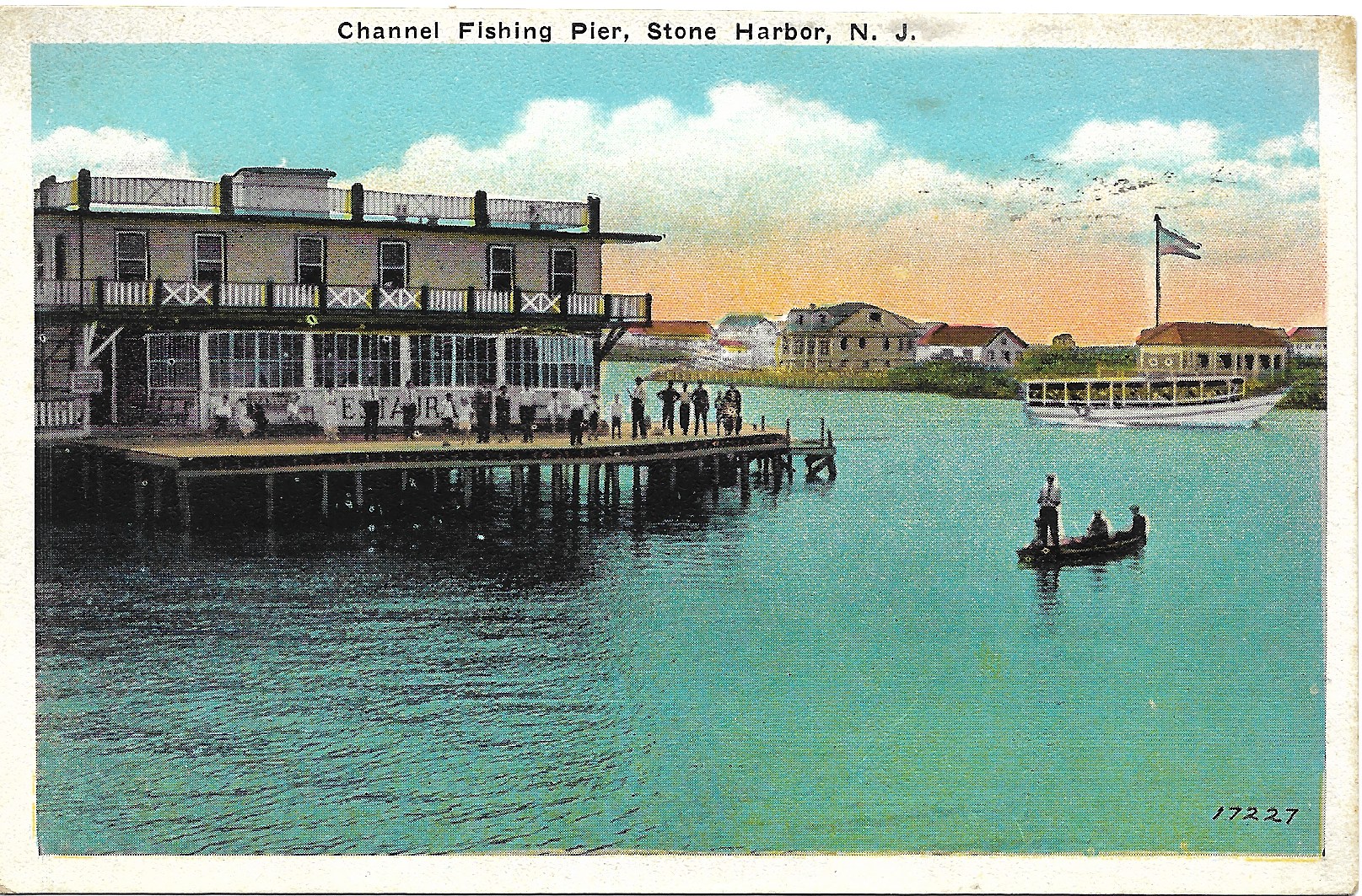
Successful completion of the Parkway Pier and Pavilion House would also result in three docks being built and providing some 1,500 square feet of wharf space. Originally there were also what were referred to as “retiring rooms” on the first floor and on top of the building above the second story there was a very nice roof garden offering travelers not only a very nice expansive view of the Great Channel but a place for refreshments while awaiting a scheduled arriving or departing ferry.
Depicted in the colorful post card shown here, bearing the caption “CHANNEL FISHING PIER”, one can see a number of people quietly seated or standing most likely waiting for the next ferry boat. Extending out over the water at the back of the building is a single diving board that you will soon learn more about. In the background to the far right, there is a departing ferry boat presumably making its way back to Anglesea with many passengers. Apparently this ferrying business for at least a good 10 to 15 years was indeed a flourishing and lucrative service especially during the summer months. For your added information, the post card included above was postmarked at Stone Harbor on AUG 19, 1924.
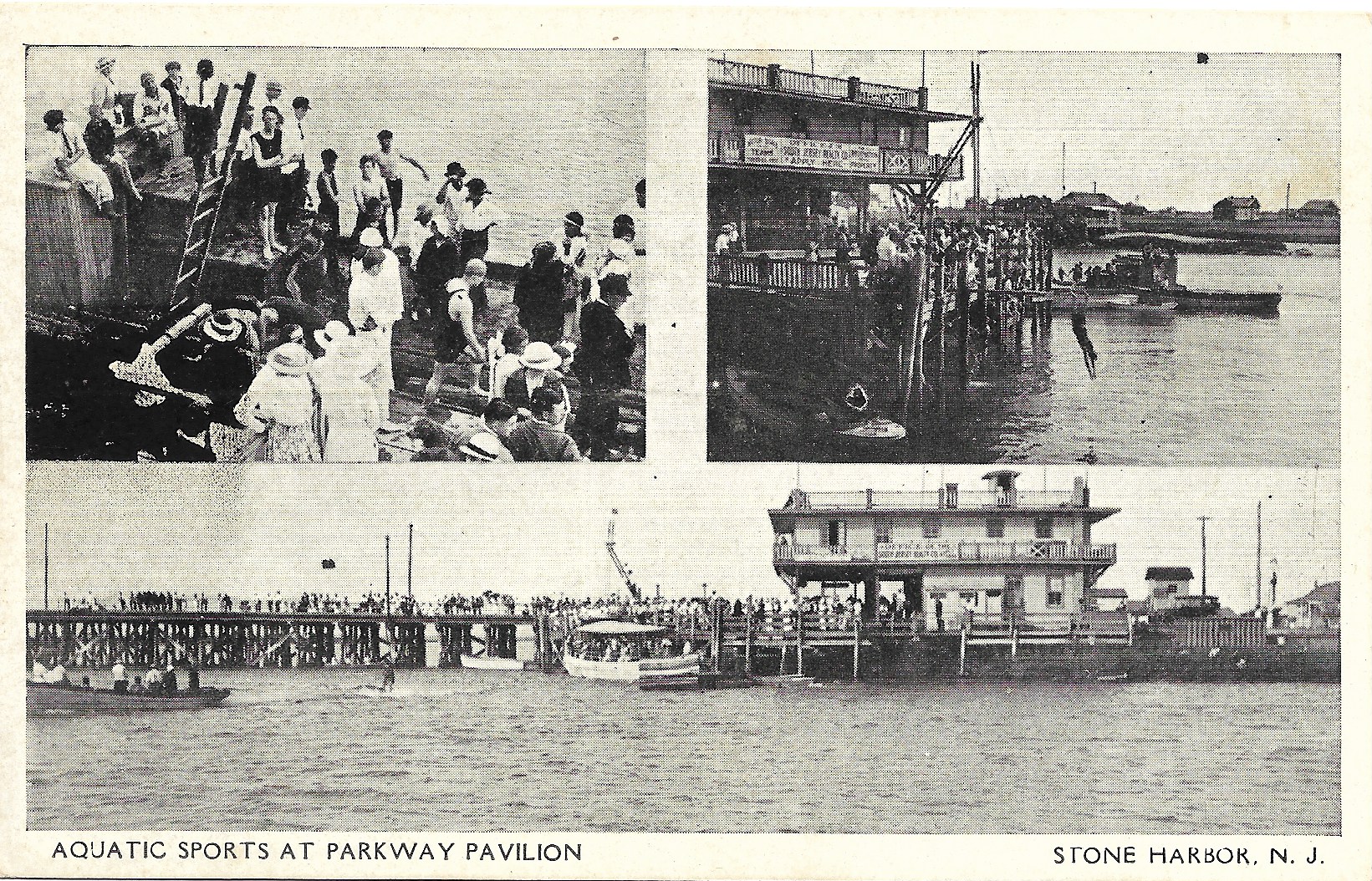
This particular multi-view post card has three separate images, each depicting different aspects of the ferry building, and bears the caption “AQUATIC SPORTS AT PARKWAY PAVILION”. On the message/address side of this post card there is a printed inscription that reads: “Saturday afternoon exhibition by pupils of the free swimming school who compete for valuable prizes. Aquaplane, high and fancy diving stunts are popular.” In addition, there is a vintage picture post card known to exist, while not available at this time, that actually shows an “interior view” of the Parkway Pavilion that stood along the pier and even illustrates the “early arcade and game area” located for a time inside the first floor of the building.
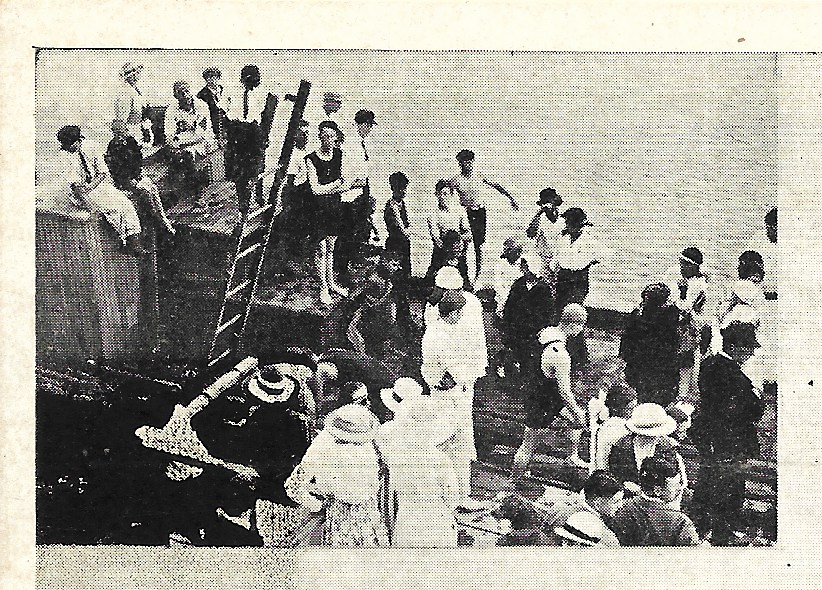
The next three images have been derived and cropped individually from this three-view post card and are provided for brief but specific treatment. First taken from the upper-left portion of the 3-view card are some male and female divers in swimwear preparing for their diving competition. With many onlookers crowding the wharf, somewhere in that group would be officials who judged the divers and their ability to perform their individual dives.
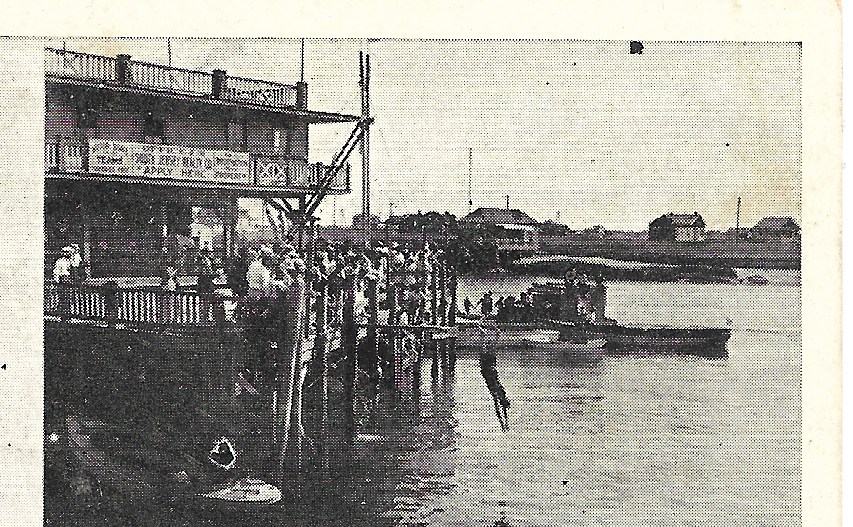
This next or second view actually shows a diver just having gone off the diving board (you will have to look closely at the center of this image) and just about to enter the water. Again there is a multitude of spectators on the deck enjoying this competition as well as a couple of boats with more onlookers in the background.

This elongated view shown at the bottom of the multi-view post card shows just how many people really attended this special water sports event. Furthermore, there is a boat on the far left side of this image and it appears to be pulling an individual across the water who is competing in the aquaplaning event which was also a very popular activity at that time. Aquaplaning entails a board on which a standing rider is towed behind a speeding motor boat. These special competitive aquatic events must have certainly provided a lot of fun and entertainment for the aquatic enthusiasts and spectators alike.
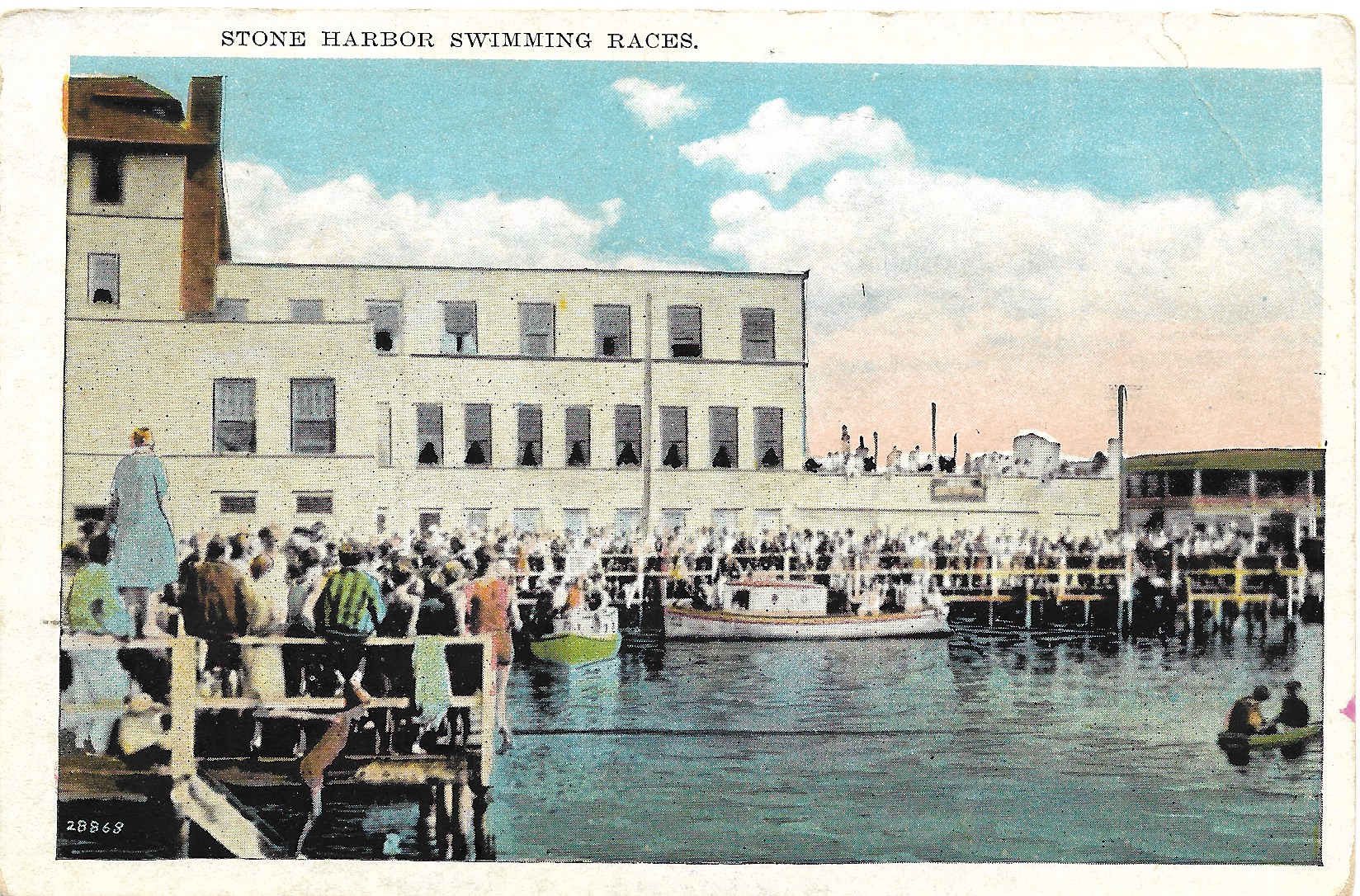
The increased popularity of such swimming races would in time also carry over to the nearby Shelter Haven Hotel portion of the basin where similar aquatic events would take place in the waters just off of their docks behind the hotel. And yes, there are picture post cards capturing those moments as well. Presented directly above is a colorful post card bearing the caption “STONE HARBOR SWIMMING RACES” postmarked and mailed in 1929 for you to enjoy. As you can readily see there were many people in attendance enjoying this particular aquatic event.
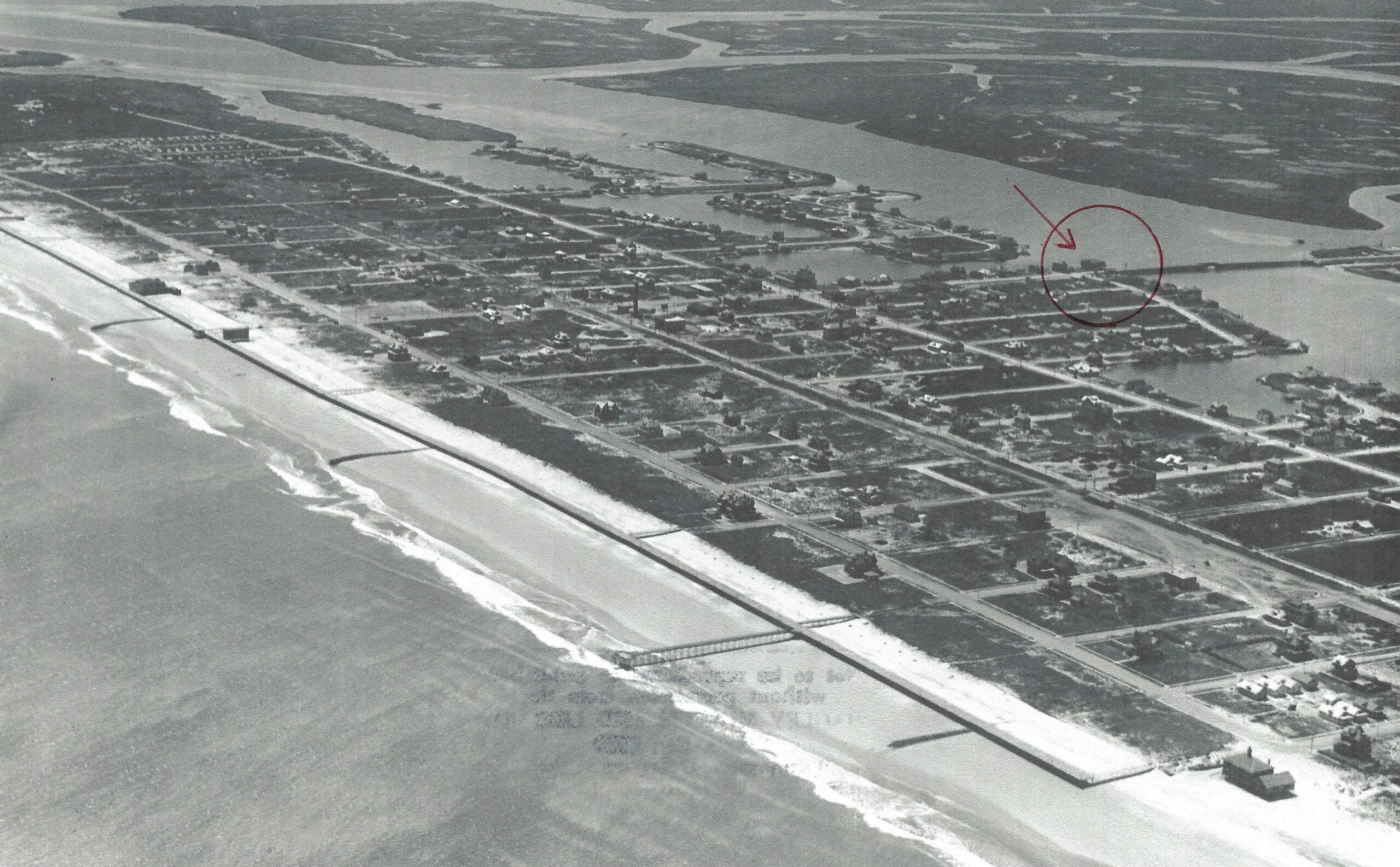
CONCLUSION: In any event, let us be very clear about the actual location of the aforementioned Parkway Pier and Pavilion House. The next image, compliments of the Stone Harbor Museum archives, is a striking aerial photograph taken from an airplane showing most all of Stone Harbor sometime around 1920. To avoid any question, the area in the upper right that is circled in red ink shows us exactly where this Pier and Pavilion/ferry building was located at the entry point of the town on 96th Street. This remarkable and expansive view also contains some other interesting landmarks that you might be familiar with including: the boardwalk running from 83rd Street to 106th Street; the 500-foot long fishing pier extending out into the ocean at the northern end of the boardwalk; the waterworks and water tower at Second Avenue and 96th Street; the Shelter Haven Hotel; and of course the multitude of little cottages comprising Bower, Weber and Stone Courts at the far left situated between Second and Third Avenues, just to mention a few. Perhaps you can locate some other buildings or points of interest included in this superb image. Seldom will we ever see a better and more complete early view of Stone Harbor taken during this time period.
In closing, it is difficult to pinpoint an actual year when the short-lived pavilion highlighted in this article no longer served its intended purpose, but I would estimate that it closed down and was most likely repurposed or possibly demolished sometime in the mid-to-latter 1920s. I am however mindful and rather certain that in the decade of the 1920s alone, the availability and growing abundance of automobiles as well as charter busses really began to have a profound impact on how people and vacationers were able to reach Stone Harbor. In due course, it became apparent that a building dedicated primarily to offering ferry services was no longer needed!
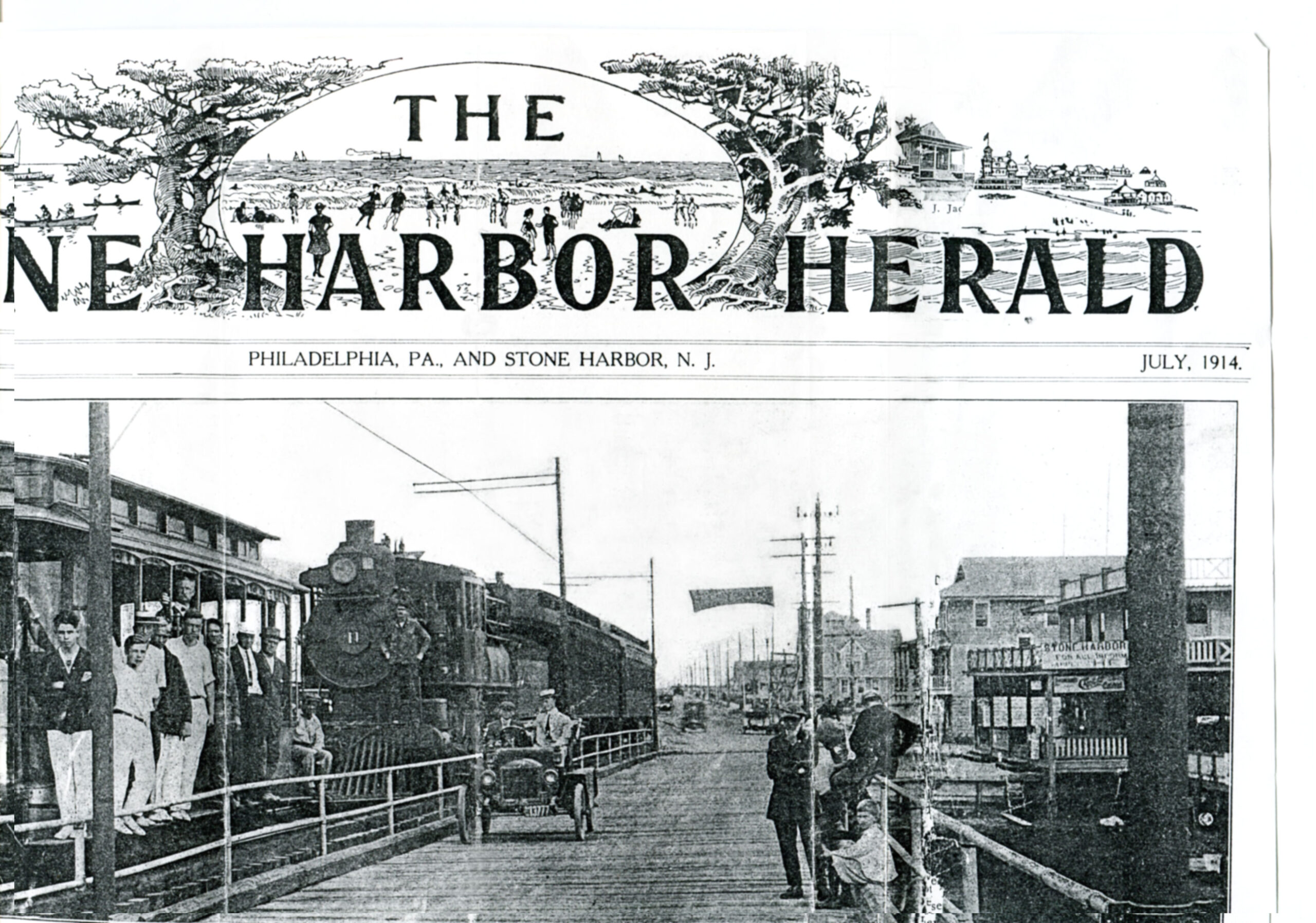
EPILOGUE: My good friend and former Director at the Stone Harbor Museum, JIM TALONE, was kind enough to send me this final image. Frankly, it is one of the most dramatic and remarkable scenes of Stone Harbor that I have ever come across. In my view it depicts an action-filled photo image taken from the “masthead” and upper front-page of the July 1914 issue of “THE STONE HARBOR HERALD” publication. While it is not a complete image or reproduction of the entire front page, it should suffice for our purposes herein because it also shows the Parkway Pier and Pavilion House. Please take a serious look at this particular image and enjoy it for exactly what it is.
There is a lot of human activity presented in this almost breathtaking photo taken right on the bridge entering Stone Harbor in 1914. First and foremost, and starting from the left, notice the Stone Harbor Terminal Railroad Company’s electric trolley, then the Pennsylvania Railroad steam locomotive pulling a couple of passenger cars and a vintage automobile with the steering wheel on the left or the other side from where we are used to driving today. These vehicles are all facing west and heading in the direction of the mainland. All we need now is to add a Wright-flyer aeroplane to this scene and we just might be able then to re-label this photo, “Planes, Trains and Automobiles”. If you get my drift here, I am referring to a certain popular John Candy and Steve Martin comedy movie of 1987 and bearing the above title. However, all joking aside – it would seem that this photo truly embodies the growing vibrancy of “Stone Harbor in the making” during the so-called “Good old days!”
QUESTION: Might any of you know just when that remarkable ferry building, called the Parkway Pier and Pavilion House, actually closed? If so, please leave a comment for us on the Facebook platform. We do hope that you have enjoyed reading and viewing the images associated with this article.
